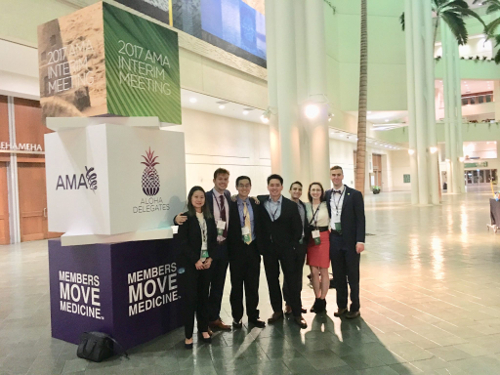
Since arriving as a first-year student at WMed in 2015, David Lee has made a point of attending annual meetings of the American Medical Association.
For Lee, the gatherings are a chance to engage with medical students from across the country, an opportunity to help shape important policy and take an active role in molding the future of medicine.
“Going to the meetings, being around like-minded people who are passionate and seeing where medicine is going and being part of that is something I find very rewarding and I see it as incumbent upon myself as a future physician to make sure that the needs of my fellow physicians and our patients have a voice,” Lee said.
In November, Lee, a third-year student at WMed, was part of a contingent of eight students from the medical school’s chapter of the AMA-Medical Student Section who attended the AMA Interim Conference in Honolulu, Hawaii. WMed had the most students at the three-day conference of any medical school in Michigan.
The students were active during the entire conference, which was held from November 9-11. Four WMed students, including Lee, introduced a total of seven policy change resolutions to the AMA-Medical Student Section General Assembly while M2 Tom Duong presented research at the AMA Scientific Meeting. Lee, who serves as vice chair of the AMA-Medical Student Section Community Service Standing Committee, also helped lead a national service project during the conference.
Duong said he appreciated the opportunity to connect with other medical students from across the country during the conference. The research Duong presented at the AMA Scientific Meeting – “Pregnancy, Crime, and Infant Outcomes” – was part of a project he worked on with Dr. Catherine Kothari, assistant professor for Biomedical Sciences within the Division of Epidemiology and Biostatistics at WMed.
M2 Erik Winterholler said the conference presented a great chance to network with other medical students and physicians. He attended the meeting of the General Assembly during the conference and submitted a resolution for the body’s consideration aimed at establishing policy within the AMA-Medical Student Section around electronic medical record security and protecting patients’ privacy and financial information.
Winterholler said the resolution was not discussed at the interim meeting because of time constraints. However, he said he received valuable feedback from other medical students during the General Assembly meeting and he plans to re-introduce the resolution at the AMA National Meeting in June in Chicago.
“With the perspective I have now, having gone to the conference and interacted with the leadership, I feel more confident bringing the proper amendments to my resolution to make it more impactful,” Winterholler said.
Gina Bravata, a classmate of Winterholler in WMed’s Class of 2020, said she was inspired by her time at the conference in Hawaii and the interactions she took part in during the General Assembly meeting.
At the meeting, she was part of a group of medical students who presented a resolution addressing implicit bias and the importance of recognizing its influence on health outcomes and the importance of it being a part of medical school education. The resolution, along with a separate resolution regarding structural racism, was passed and adopted as policy by the AMA-Medical Student Section.
“I think one of the things that being in the AMA has shown me is there is a large network of medical students and physicians out there that care about the issues we talk about here at WMed and if you can plug into that network you can get a lot done in a very short period of time,” Bravata said. “Seeing the types of resolutions that were being supported by the Medical Student Section and the Physicians Section made me really hopeful for the future of medicine.”
Lee said his work and involvement with the AMA-Medical Student Section has been extremely valuable for him and other members of the chapter at WMed “to see what medicine is like outside the walls of Kalamazoo and give your aspirations a chance to flourish outside of your communities with those who are like-minded.”
Lee was plenty busy at the interim conference in Honolulu. He helped introduce four resolutions to the General Assembly and was in charge of organizing the national service project, which centered around addressing the opioid epidemic in the U.S.
Lee said that in Hawaii, a major health concern is the use of opioids among homeless people. So, as part of the national service project, Lee worked with the chair of the AMA-Medical Student Section Community Service Standing Committee to host a health fair where community members had access to a host of local resources, including representatives from the state’s Department of Health and a needle exchange project. The committee also held a training session where medical students worked with local EMS employees during a hands-on training on the use of Naloxone.
Lee said his group also collaborated with the AMA-Medical Student Section Committee on Legislative Action to present an informational seminar on the opioid epidemic and how medical students at the conference could take the national service project and replicate it in the communities where they are currently attending medical school.
“We wanted to turn the national service project into something more longitudinal and something that will have a more lasting impact,” Lee said.
